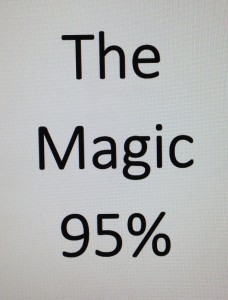 When someone says, “I have a 95% close rate!” two things probably pop into your mind. This person is either full of B.S. or is using very persuasive sales tactics to charm people into buying their product. (Think Rasputin.). Over the years, I’ve come across my fair share of these types of people, and I dare say, it’s a little unnerving when I hear these grandiose claims.
When someone says, “I have a 95% close rate!” two things probably pop into your mind. This person is either full of B.S. or is using very persuasive sales tactics to charm people into buying their product. (Think Rasputin.). Over the years, I’ve come across my fair share of these types of people, and I dare say, it’s a little unnerving when I hear these grandiose claims.
The good news–there is a way to obtain a 95% close rate (or better) without lying or charming someone into a closing. The concept is simple: Create a pipeline of perfect fit prospects from a referral partner–someone who knows what you do, knows how you do it, knows how much you charge, and voila! You eventually get your magic 95%!
The success or failure of this bold concept hinges on one aspect–appropriate referral partners. The best way to identify, find, and develop well-suited referral partners is to use a solid Referral Partner Cultivation Process (aka a RPCP). Note: There are two prerequisites in this process:
- You need to identify, how your organization AND your product are significantly different from others.
- You need to take time to define the exact qualities of your perfect fit clients. (If you aren’t crystal clear on who you’re looking for, you’ll likely miss great opportunities as well as warning signs!)
Once you are clear on these specifics, you’ll be ready to develop your RPCP.
The Three Phases of a Successful RPCP:
Phase 1 – Finding the right referral partner
This can take time because it involves several moving parts. First, you need to figure out who customarily works with your perfect fit clientele. Let’s use Certified Public Accountant (CPA) as an example: Who else regularly works with CPA’s? Lawyers, business coaches, business owners, HR professionals, CFOs, etc.
Once you’ve identified other professionals who regularly interact with CPAs, do some research and identify specific individuals (or organizations) with whom you’d consider creating a referral relationship. You can find good ones via Google searches, LinkedIn contacts, and by asking around at networking events. (LinkedIn is an especially useful resource nowadays.) Continue searching until you’ve created an A-list of candidates.
Next, screen your candidates! You might be eager to get together with them immediately to explore possibilities and talk strategies, but in doing so, you’re likely setting the stage for a less than optimal relationship–and at the far end of that spectrum, a potential referral disaster!
To optimize your efforts and minimize the potential for trouble down the road, I suggest creating a simple interview process designed to identify specific, desirable, professional traits. Here are some aspects to consider:
- Level of professionalism in their interactions with you. For example: Are they punctual? Organized? Personable? Presentable? (Yes, that does matter.) Timely with following up?
- Their business philosophy, integrity, personal principles and practices.
- Stage in their professional life: Are they a ramp-up or a 30 year vet?
In addition, you’ll want to ask questions to uncover preliminary referral concerns like:
- Do they already have an arrangement with another professional who offers the same service you offer?
- Are there any restrictions in terms of their referral policies? (In some cases, there are restrictions and regulations in the context of industry compliance.)
- Are there any other conflicts of interest?
By creating a thorough screening process, you’ll be able to line up prime candidates who, in turn, might become long-lasting referral partners down the road.
In my NEXT article …I’ll dive into Phase 2 and Phase 3: Defining the relationship and Minding the relationship.
I’ll also answer the #1 question frequently asked about cultivating referral partnerships: Is it really worth the time and trouble?




